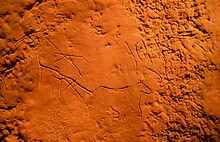Cova Fosca
The Cova Fosca ( Catalan for "Dark Cave") is a prehistoric cave in the area of the municipality of La Vall d'Ebo in the province of Alicante in Spain . The Paleolithic rock paintings found in it probably come from the Magdalenian and are the oldest in the province of Alicante. There is a cave of the same name in Mallorca .
The Cova Fosca has two entrances and is because of the images that date back to 15,000 BC. Be dated, protected. The pictures show deer, horses and zoomorphic beings of an indefinite nature. There are also panels with geometric and linear symbols. In an area where rock paintings under abrises (Abric d'Ermites IV) are typical of rock art, this Levantine cave takes on the role of Franco-Cantabrian, Paleolithic art with images in the depths of caves. In the Valencia region, a few other caves of this type contain Paleolithic art (Cova Parpalló, Cova de Reinós, and Cueva Meravelles).
The cave was not only visited in the Paleolithic. Like the Cova de l'Or and the caves of the Barranco de los Grajos, it was used during the Neolithic and used as a burial cave during the Copper Age .
Mollusc remains from the Cova Fosca are considered evidence of human use of the cave in the first half of the Holocene. But neither the pulmonate ( lung snails ) nor the sea clams represent food waste. The small size ( 7-30 mm) of the dominant pulmonates ( Pomatias elegans and Rumina decollata ) and the lack of human traces on them show their character. Together with the other eight types of pulmonate, they testify to the change in climatic conditions from the Epipaleolithic to the late Neolithic. The marine molluscs, on the other hand, represent either the manufacture of tools or jewelry.
See also
literature
- Jose Aparicio Perez: La Cova Fosca: (Ares del Maestre-Castellon) y el neolitico Valenciano (Arqueologica series) .
Web links
Coordinates: 38 ° 48 ′ 4.3 " N , 0 ° 9 ′ 57" W.
